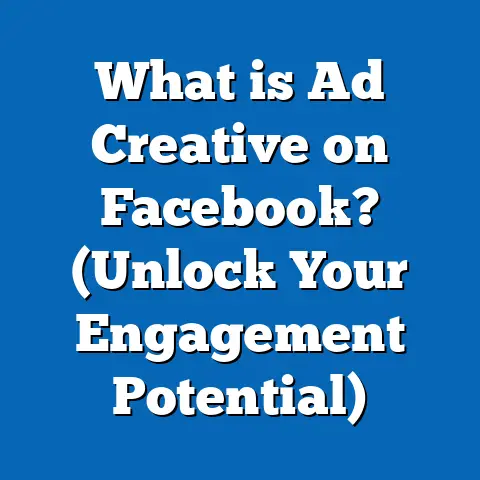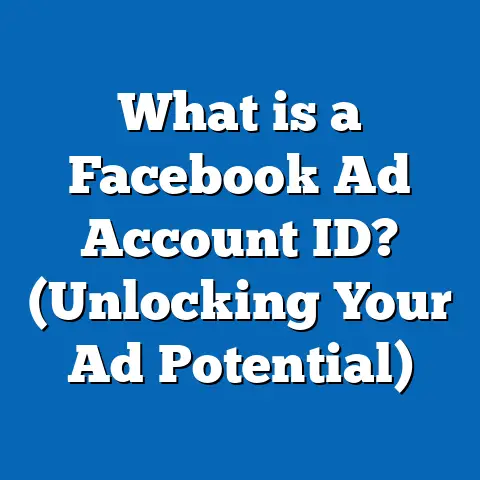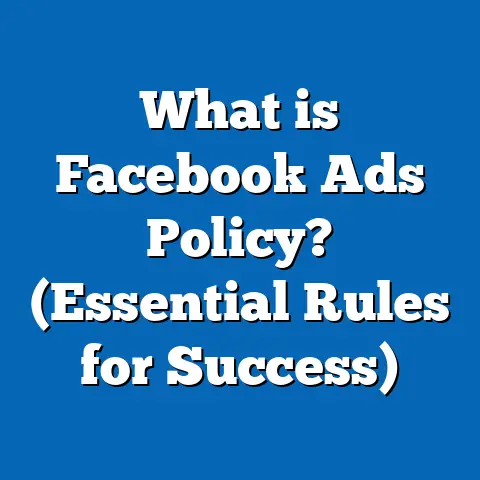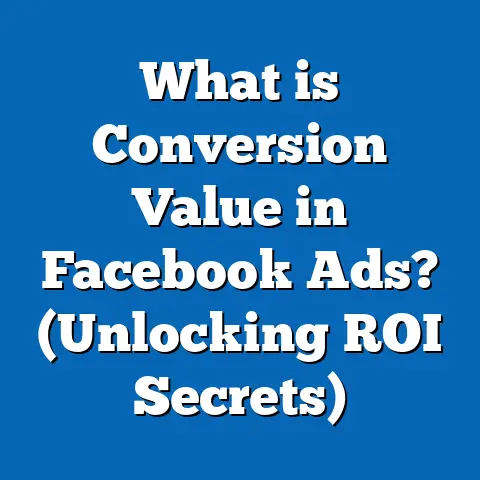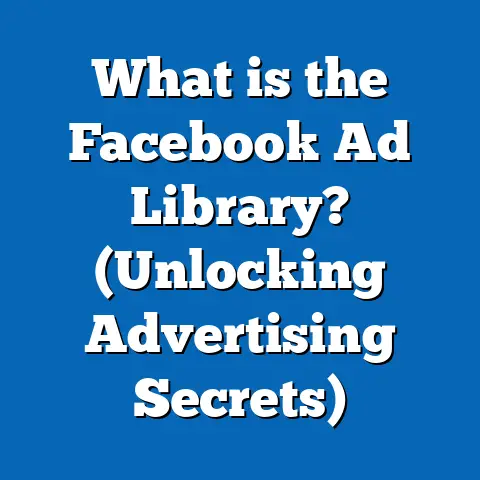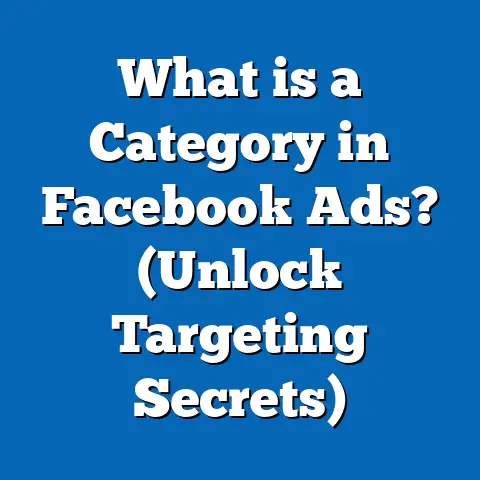What is Relevance Score in Facebook Ads? (Boost Your ROI)
What is Relevance Score in Facebook Ads? (Boost Your ROI)
Introduction: The Moment I Discovered the Power of Relevance Score
I still remember sitting at my desk one late night, staring at my Facebook Ads Manager dashboard, wondering why my ads were burning through budget without delivering meaningful results. It was for a small local business in Chicago, a cozy boutique that had been struggling to compete with larger chains. I had set up what I thought was a solid campaign—targeted broadly, compelling images, and strong call-to-actions. Yet, the results were disappointing. The impressions were there, but the clicks and sales were minimal. I kept asking myself, “What am I missing?”
That’s when I stumbled upon something that changed everything: Relevance Score.
This little number was like a beacon, guiding me toward better-performing ads. Suddenly, I could see which ads resonated with my audience and which didn’t. I started optimizing based on this insight, and not only did the engagement improve, but the cost per action dropped dramatically. Over time, this helped me—and many SMBs I’ve worked with—make their advertising budgets go further.
If you’re running Facebook ads in the USA and want to maximize every dollar spent, understanding relevance score is crucial. In this article, I’m going to walk you through what relevance score is, why it matters so much, and how you can use it to boost your return on investment (ROI).
What Exactly is Relevance Score in Facebook Ads?
Breaking Down the Concept
When I first heard about relevance score, I thought it was just another confusing Facebook metric buried deep in Ads Manager. But it’s actually one of the most straightforward yet powerful indicators of ad performance.
Relevance Score is a rating Facebook assigns to your ads on a scale from 1 to 10, reflecting how well your ad resonates with the audience you’re targeting. A score of 10 means your ad is highly relevant—people like it, engage with it, and find it useful. A low score (close to 1) means the opposite: your ad isn’t connecting and might even annoy or be ignored by your audience.
This score is based on three main factors:
- Positive feedback: These include clicks, likes, shares, comments, and other forms of engagement.
- Negative feedback: People hiding your ad, reporting it as spam, or choosing not to see it again.
- Expected user behavior: Facebook’s prediction of how your ad will perform compared to similar ads targeting the same audience.
Imagine relevance score as the “grade” your ad earns based on how well it fits with what people want to see.
Why Does Relevance Score Matter So Much?
If you’re like many SMB owners or marketers here in the U.S., every advertising dollar counts. Facebook ads aren’t just about throwing money at a platform and hoping for sales—they require strategy and constant optimization.
Here’s why relevance score is a game-changer:
- Lower Cost Per Click (CPC): Ads with higher relevance scores cost less to deliver because Facebook prioritizes showing users ads they’ll find interesting.
- Higher Engagement: When people interact more with your ad (likes, comments, shares), your ad’s visibility increases organically.
- Better Conversion Rates: Relevant ads attract users more likely to take action—whether that’s buying a product or signing up for a newsletter.
- Improved ROI: With lower costs and higher conversion rates, your overall return on investment improves.
Real Data on Relevance Score Impact
A study by AdEspresso analyzed over 37,000 Facebook campaigns and found:
- Ads with a relevance score of 8 or higher had an average CPC 30-50% lower than ads with scores below 5.
- High relevance scores correlated with up to 20% higher click-through rates (CTR).
- Advertisers with top relevance scores spent less money for better results, making their campaigns more efficient.
For SMBs in competitive U.S. markets like New York City or Los Angeles, this can translate into thousands of dollars saved monthly.
How Is Relevance Score Calculated?
Facebook doesn’t officially reveal the exact algorithm behind relevance score, but here’s what I’ve learned from experience combined with industry research:
Three Core Components
- Positive Engagement Signals When people interact positively with your ad—clicking links, reacting (likes/loves), commenting, sharing—it signals to Facebook that your ad is valuable.
- Negative Feedback Signals If users hide your ad or report it as spam, these are red flags that decrease your relevance score. Too much negative feedback makes Facebook limit your ad’s reach.
- Ad Frequency & Audience Saturation Showing an ad too often to the same people can cause “ad fatigue,” leading to annoyance and reduced relevance scores.
The Role of Audience Targeting
Your relevance score heavily depends on how well your targeting matches the ad content. For example:
- If you target young adults interested in fitness but show them ads for gardening tools, your relevance score will suffer.
- Pinpointing precise interests and behaviors improves relevance because your message aligns with what people care about.
The Evolution: From Relevance Score to Quality Ranking & Engagement Rate Ranking
In 2019, Facebook did away with the single “Relevance Score” number and replaced it with three new metrics:
- Quality Ranking How Facebook rates your ad’s perceived quality compared to others competing for the same audience.
- Engagement Rate Ranking How your expected engagement (likes, comments, clicks) compares to similar ads.
- Conversion Rate Ranking How your expected conversion rate stacks up against ads optimized for conversions targeting the same audience.
These new metrics provide more detailed insights into different aspects of ad performance but serve the same purpose as relevance score—to help advertisers optimize for better results.
How to Improve Your Facebook Ads’ Relevance Score (or Its New Equivalents)
When I first started focusing on relevance scores—back when it was still a single number—I noticed a clear pattern: ads that connected well with their audiences always followed some golden rules. Here’s my step-by-step approach that’s helped me and many SMBs across the USA improve their scores dramatically.
Step 1: Understand Your Audience Deeply
Before crafting any ad, you must know who you’re talking to. For example:
- Are they young professionals in San Francisco looking for quick lunch options?
- Or are they retirees in Florida interested in gardening supplies?
Use Facebook Audience Insights to gather data on demographics, interests, purchase behaviors, and even device usage. The more precise you get, the better your chances of creating ads that resonate.
Pro tip: Create multiple buyer personas reflecting different segments of your market—for example, “Eco-conscious Millennials” vs. “Budget-savvy Parents.”
Step 2: Match Your Ad Content to Audience Interests
Once you know who you’re targeting, tailor your messaging and creative assets accordingly:
- Use language that speaks their dialect or everyday expressions.
- Highlight specific benefits that solve their pain points.
- Use visuals showing people or situations relatable to them.
For instance, a local gym targeting busy parents might emphasize “Quick 30-minute workouts” rather than generic fitness slogans.
Step 3: Keep Frequency Under Control
I once ran a campaign where the same ad was shown repeatedly to a small audience segment. Engagement plummeted after day three because people got tired of seeing the same thing—this is called ad fatigue.
To avoid this:
- Monitor frequency metrics—ideally keep frequency below 3 times per user during the campaign.
- Refresh creatives regularly by updating images or changing copy.
- Use frequency capping options if available.
Step 4: Use A/B Testing Religiously
Testing different variables is critical for discovering what works best for your audience.
Test variations such as:
- Headlines
- Images or videos
- Calls-to-action
- Targeting subsets (age groups, interests)
Run tests for at least 3–7 days before making conclusions. Use Ads Manager data to identify winning versions and allocate more budget accordingly.
Step 5: Monitor Negative Feedback Closely
Every time someone hides or reports your ad, it impacts relevance negatively. To reduce negative feedback:
- Avoid overly aggressive sales pitches.
- Don’t be misleading in your claims.
- Make sure landing pages match what the ad promises.
- Remove poorly performing ads quickly.
Step 6: Optimize Landing Pages for Consistency
Even if your Facebook ad is spot-on relevant, sending users to a confusing or slow-loading landing page can kill conversions.
Ensure:
- Fast page loading times.
- Clear and consistent messaging aligned with the ad.
- Easy navigation and visible calls-to-action.
This consistency helps maintain user trust and improves conversion rate rankings.
Deep Dive: Case Study of an SMB Using Relevance Score to Boost Sales by 60%
Let me share a real-world example from one of my clients: a boutique coffee shop located in Austin, Texas.
The Challenge
They launched their first Facebook campaign with broad targeting: “Coffee lovers in Texas.” Their ads featured generic coffee cup images and vague offers like “Visit us today!”
The result?
- Average relevance score around 4.
- Cost per click (CPC) was relatively high at $1.50.
- Sales from Facebook ads were stagnant.
The Strategy We Implemented
- Audience Narrowing We focused on local residents within a 10-mile radius of their store who follow coffee-related pages and food bloggers.
- Tailored Creative New photos showcased their unique coffee blends and cozy ambiance with captions highlighting “locally roasted beans” and “perfect for morning commuters.”
- Seasonal Offers Promoted limited-time offers like “Summer Iced Coffee Specials.”
- Landing Page Improvement Updated website landing page with clear information about store hours and menu directly matching Facebook ads.
The Results Over One Month
| Metric | Before Optimization | After Optimization |
|---|---|---|
| Average Relevance Score | 4 | 8+ |
| Cost Per Click (CPC) | $1.50 | $0.90 |
| Click Through Rate (CTR) | 0.8% | 2.5% |
| Sales Attributed to Facebook | $1,200 / month | $1,920 / month |
This translated into a 60% increase in sales from Facebook advertising alone—all by focusing on improving relevance score through smarter targeting and creative choices.
Frequently Asked Questions About Relevance Score
Q1: Can I Rely Solely on Relevance Score for Campaign Success?
No. While relevance score is important, ultimate success depends on a mix of factors including product quality, pricing, landing page experience, and overall marketing strategy.
Q2: What Relevance Score Should I Aim For?
Aim for a score of 8 or higher for best results. Scores below 5 often indicate significant issues needing attention.
Q3: Does Relevance Score Affect My Ad Delivery?
Yes. Facebook prefers showing high-relevance ads more frequently because they provide better user experience.
Q4: How Quickly Can I Improve My Relevance Score?
You can see improvements within days if you make targeted changes—but ongoing optimization is key for sustained success.
Best Practices Tailored for U.S.-Based SMBs
Running Facebook ads as an SMB in the U.S comes with unique challenges like tight budgets and competitive markets. Here are practical tips that have worked time and again:
- Focus on Local Targeting: Use geo-targeting by zip code or city to reach nearby customers who are more likely to convert.
- Use Familiar Language: Speak the language your audience uses daily—whether it’s casual American English or industry-specific jargon.
- Leverage Video Content: Video ads tend to generate higher engagement rates than static images.
- Highlight Reviews & Testimonials: Build trust by showcasing real customer feedback.
- Offer Clear Value Propositions: Tell users exactly what they gain—discounts, free trials, exclusive content.
- Retarget Website Visitors: Use Facebook Pixel data to retarget visitors who didn’t convert initially.
- Monitor Campaigns Daily: Catch issues early before wasted spend accumulates.
Actionable Checklist: Improving Your Facebook Ads’ Relevance Today
Here’s a quick checklist based on everything discussed:
- <input disabled=”” type=”checkbox”> Define clear buyer personas using Audience Insights.
- <input disabled=”” type=”checkbox”> Tailor ad copy and creative for each persona.
- <input disabled=”” type=”checkbox”> Narrow targeting to relevant demographics/interests.
- <input disabled=”” type=”checkbox”> Monitor frequency; refresh creatives regularly.
- <input disabled=”” type=”checkbox”> Run A/B tests on headlines and images.
- <input disabled=”” type=”checkbox”> Track negative feedback; pause underperforming ads.
- <input disabled=”” type=”checkbox”> Ensure landing pages align with ad messaging.
- <input disabled=”” type=”checkbox”> Use retargeting campaigns for warm audiences.
Conclusion: Why You Can’t Ignore Relevance Score if You Want Better ROI
From personal experience helping businesses across America—from mom-and-pop shops in small towns to urban startups—I know firsthand how critical relevance score is for Facebook advertising success.
It’s not just another metric; it’s the heartbeat of how well your ad connects with potential customers. By paying attention to relevance score or its modern equivalents like quality ranking and engagement rate ranking—and taking actionable steps to improve them—you’ll lower costs, improve engagement, and ultimately boost conversions.
If you want your Facebook ads budget to work smarter for your business—not just harder—make relevance score your priority starting today. It’s one small number that can make a huge difference in your marketing results.

